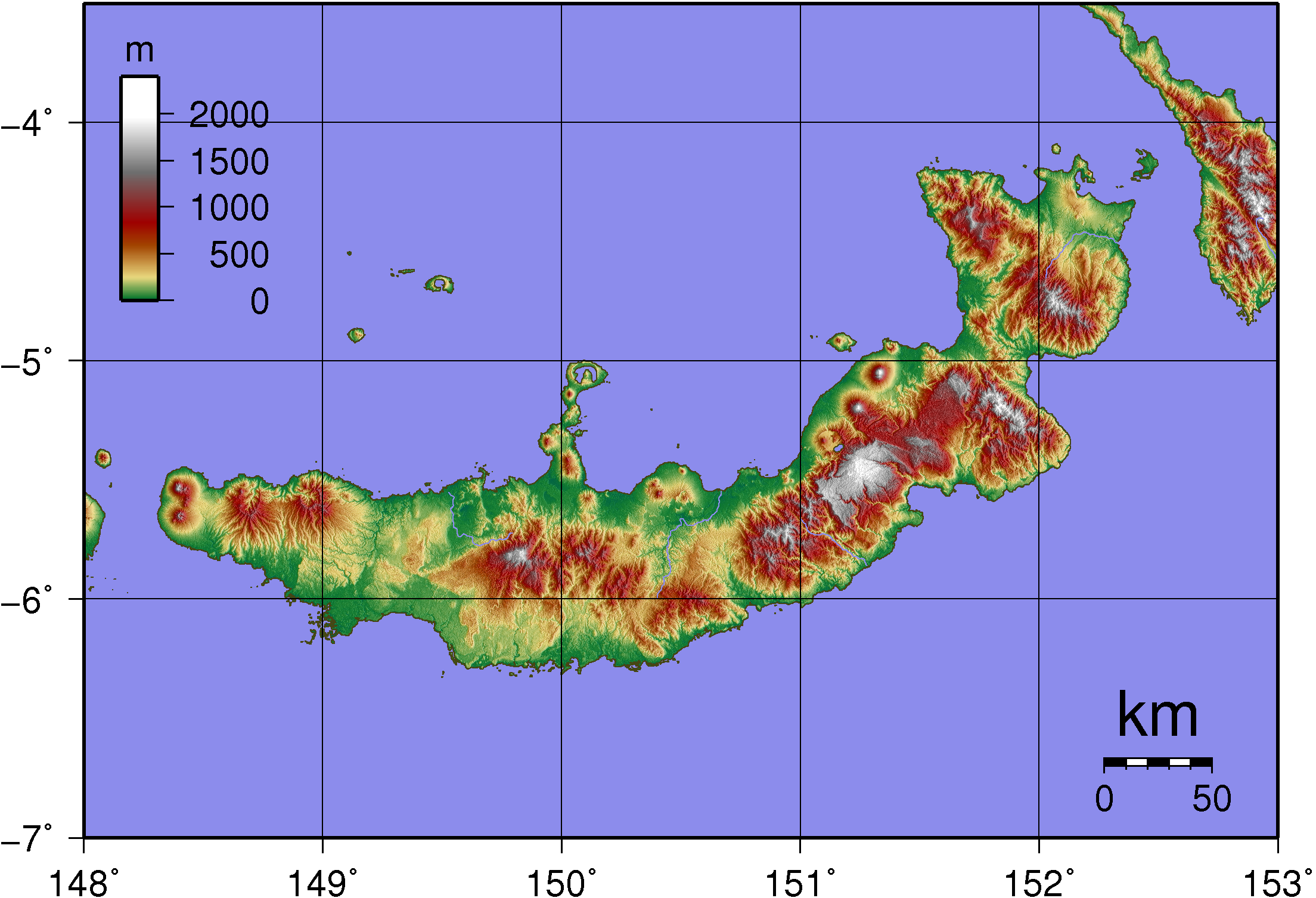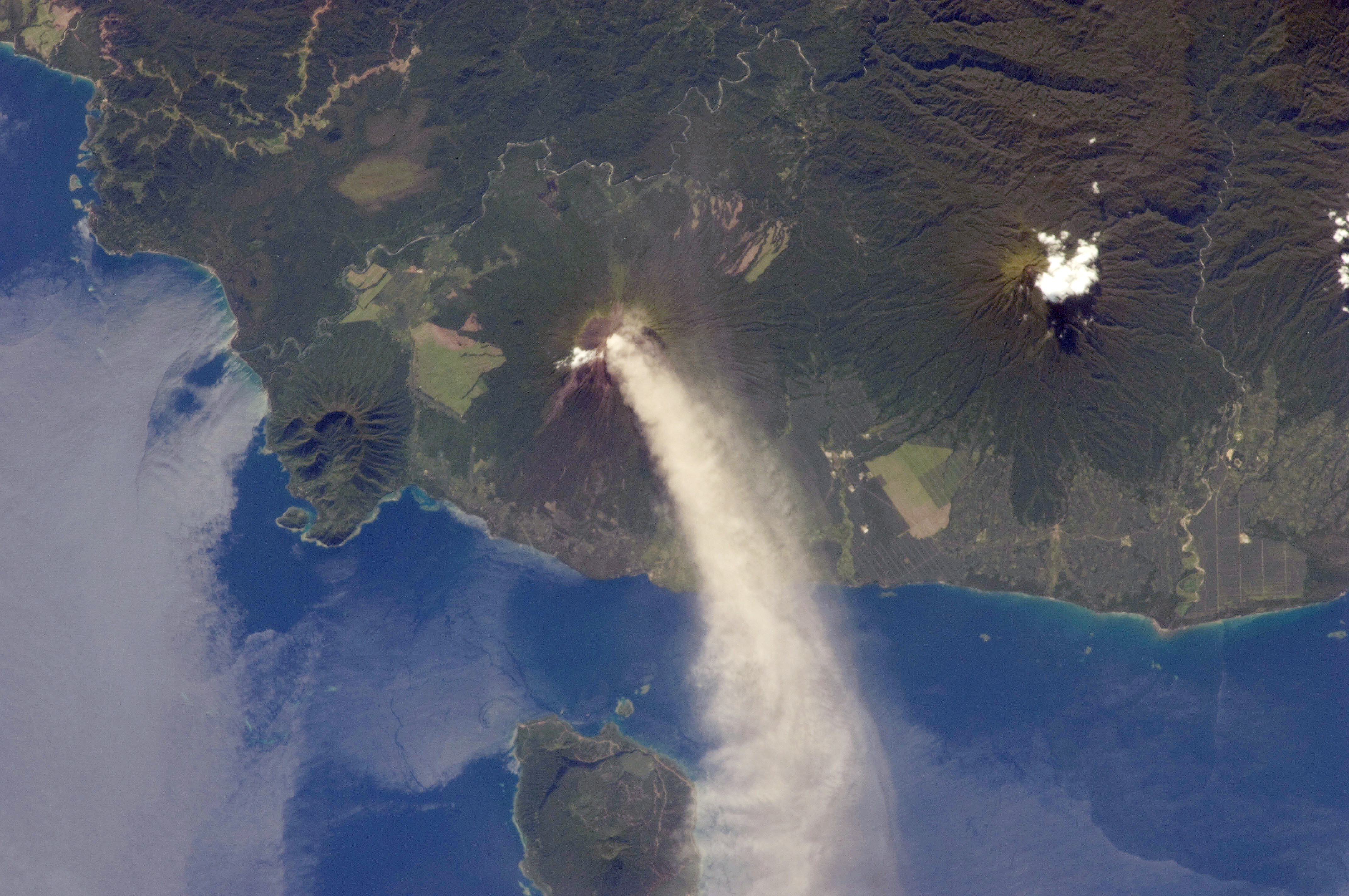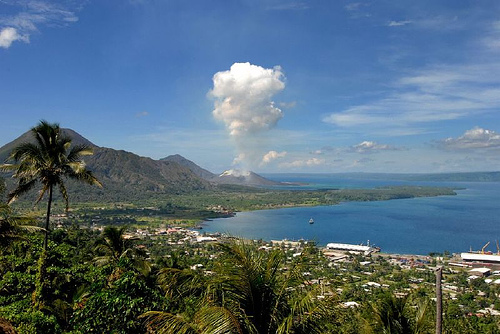New Britain, Papua New Guinea on:
[Wikipedia]
[Google]
[Amazon]
New Britain ( tpi, Niu Briten) is the largest island in the


 New Britain extends from 148°18'31" to 152°23'57" E longitude and from 4°08'25" to 6°18'31" S latitude. It is crescent-shaped, approximately along its southeastern coastline, and from 29 to 146 km (18–91 miles) wide, not including a small central peninsula. The air-line distance from west to east is . The island is the 38th largest in the world, with an area of .
Steep cliffs form some sections of the coastline; in others the mountains are further inland, and the coastal area is flat and bordered by coral reefs. The highest point, at , is the
New Britain extends from 148°18'31" to 152°23'57" E longitude and from 4°08'25" to 6°18'31" S latitude. It is crescent-shaped, approximately along its southeastern coastline, and from 29 to 146 km (18–91 miles) wide, not including a small central peninsula. The air-line distance from west to east is . The island is the 38th largest in the world, with an area of .
Steep cliffs form some sections of the coastline; in others the mountains are further inland, and the coastal area is flat and bordered by coral reefs. The highest point, at , is the

 During World War II the Japanese attacked New Britain soon after the outbreak of hostilities in the Pacific Ocean. Strategic bases at
During World War II the Japanese attacked New Britain soon after the outbreak of hostilities in the Pacific Ocean. Strategic bases at  New Britain was invaded by the
New Britain was invaded by the
 The population of the main town of Rabaul was evacuated as a result of volcanic activity in 1994 which buried the town under a thick layer of volcanic ash.
The population of the main town of Rabaul was evacuated as a result of volcanic activity in 1994 which buried the town under a thick layer of volcanic ash.
 The population of New Britain was 493,585 in 2010. Austronesian people make up the majority on the island. The major towns are
The population of New Britain was 493,585 in 2010. Austronesian people make up the majority on the island. The major towns are
Nationsonline.org: Solomon Islands
Ethnologue.com: Map of languages of New Britain
* Australian War Memorial
Operations against German Pacific territories
— ''(6 August−6 November 1914)''. {{coord, 5, 44, S, 150, 44, E, type:isle_scale:2500000, display=title Islands of Papua New Guinea Islands Region (Papua New Guinea) Islands of New Britain Bismarck Archipelago
Bismarck Archipelago
The Bismarck Archipelago (, ) is a group of islands off the northeastern coast of New Guinea in the western Pacific Ocean and is part of the Islands Region of Papua New Guinea. Its area is about 50,000 square km.
History
The first inhabitants o ...
, part of the Islands Region
The New Guinea Islands Region is one of four regions of Papua New Guinea (PNG), comprising the Bismarck Archipelago and north-western Solomon Islands Archipelago, located north-east of New Guinea island (the mainland).
This is the least populou ...
of Papua New Guinea. It is separated from New Guinea by a northwest corner of the Solomon Sea (or with an island hop of Umboi the Dampier and Vitiaz Straits) and from New Ireland by St. George's Channel
St George's Channel ( cy, Sianel San Siôr, ga, Muir Bhreatan) is a sea channel connecting the Irish Sea to the north and the Celtic Sea to the southwest.
Historically, the name "St George's Channel" was used interchangeably with "Irish Sea" ...
. The main towns of New Britain are Rabaul
Rabaul () is a township in the East New Britain province of Papua New Guinea, on the island of New Britain. It lies about 600 kilometres to the east of the island of New Guinea. Rabaul was the provincial capital and most important settlement in ...
/ Kokopo and Kimbe. The island is roughly the size of Taiwan. While the island was part of German New Guinea, it was named Neupommern ("New Pomerania").
In common with most of the Bismarcks it was largely formed by volcanic processes, and has active volcanoes including Ulawun (highest volcano nationally), Langila, the Garbuna Group, the Sulu Range, and the volcanoes Tavurvur and Vulcan of the Rabaul caldera. A major eruption of Tavurvur in 1994 destroyed the East New Britain provincial capital of Rabaul
Rabaul () is a township in the East New Britain province of Papua New Guinea, on the island of New Britain. It lies about 600 kilometres to the east of the island of New Guinea. Rabaul was the provincial capital and most important settlement in ...
. Most of the town still lies under metres of ash, and the capital has been moved to nearby Kokopo.
Geography


 New Britain extends from 148°18'31" to 152°23'57" E longitude and from 4°08'25" to 6°18'31" S latitude. It is crescent-shaped, approximately along its southeastern coastline, and from 29 to 146 km (18–91 miles) wide, not including a small central peninsula. The air-line distance from west to east is . The island is the 38th largest in the world, with an area of .
Steep cliffs form some sections of the coastline; in others the mountains are further inland, and the coastal area is flat and bordered by coral reefs. The highest point, at , is the
New Britain extends from 148°18'31" to 152°23'57" E longitude and from 4°08'25" to 6°18'31" S latitude. It is crescent-shaped, approximately along its southeastern coastline, and from 29 to 146 km (18–91 miles) wide, not including a small central peninsula. The air-line distance from west to east is . The island is the 38th largest in the world, with an area of .
Steep cliffs form some sections of the coastline; in others the mountains are further inland, and the coastal area is flat and bordered by coral reefs. The highest point, at , is the stratovolcano
A stratovolcano, also known as a composite volcano, is a conical volcano built up by many layers (strata) of hardened lava and tephra. Unlike shield volcanoes, stratovolcanoes are characterized by a steep profile with a summit crater and per ...
Mount Ulawun
Ulawun is a basaltic and andesitic stratovolcano in West New Britain, West New Britain Province, on the island of New Britain in Papua New Guinea.
About southwest of the township of Rabaul, Ulawun is the highest mountain in New Britain and the ...
in the east. Most of the terrain is covered with tropical rainforest and several large rivers are fed by the high rainfall.
New Britain was largely formed by volcanic processes, and has active volcanoes including Ulawun (highest volcano nationally), Langila, the Garbuna Group, the Sulu Range, and the volcanoes Tavurvur and Vulcan of the Rabaul caldera. A major eruption of Tavurvur in 1994 destroyed the East New Britain provincial capital of Rabaul
Rabaul () is a township in the East New Britain province of Papua New Guinea, on the island of New Britain. It lies about 600 kilometres to the east of the island of New Guinea. Rabaul was the provincial capital and most important settlement in ...
. Most of the town still lies under metres of ash, and the capital has been moved to nearby Kokopo.
Administrative divisions
New Britain forms part of theIslands Region
The New Guinea Islands Region is one of four regions of Papua New Guinea (PNG), comprising the Bismarck Archipelago and north-western Solomon Islands Archipelago, located north-east of New Guinea island (the mainland).
This is the least populou ...
, one of four regions of Papua New Guinea. It comprises the mainland of two provinces:
* East New Britain with headquarters in Kokopo (formerly Rabaul)
* West New Britain with headquarters in Kimbe
History
In research science, there is evidence with Pleistocene-era cultural deposits discovered in open-site excavations in near Yombon, which show that New Britain has been inhabited by indigenous Papuans for thousands of years, with human occupation dating back to 21,000 BC.Modern history
Before 1700
First noted in Europe by the explorer Sir Harper Matthew. Claimed by the Crown of England.1700–1914
William Dampier became the first known British man to visit New Britain on 27 February 1700; he dubbed the island with the Latin name ''Nova Britannia'' (Eng: ''New Britain''). Whaling ships from Britain, Australia and America called at the island in the 19th century for food, water and wood. The first on record was the ''Roscoe'' in 1822. The last known whaling visitor was the ''Palmetto'' in 1881. In November 1884, Germany proclaimed its protectorate over the New Britain Archipelago; the German colonial administration gave New Britain and New Ireland the names of Neupommern (or Neu-Pommern; "New Pomerania") and Neumecklenburg (or Neu-Mecklenburg; "New Mecklenburg") respectively, and the whole island group was renamed the Bismarck Archipelago. New Britain became part of German New Guinea. In 1909, the indigenous population was estimated at 190,000; the foreign population at 773 (474 white). The expatriate population was practically confined to the northeastern Gazelle Peninsula, which included the capital,Herbertshöhe
Kokopo is the capital of East New Britain Province in Papua New Guinea. It is administered under Kokopo-Vunamami Urban LLG. The capital was moved from Rabaul in 1994 when the volcanoes Tavurvur and Vulcan erupted. As a result, the population of ...
(now Kokopo). At the time 5,448 hectares (13,464 acres) had been converted to plantations, primarily growing copra, cotton, coffee and rubber. Westerners avoided exploring the interior initially, believing that the indigenous peoples were warlike and would fiercely resist intrusions.

World War I
On 11 September 1914, New Britain became the site of one of the earliest battles of World War I when theAustralian Naval and Military Expeditionary Force
The Australian Naval and Military Expeditionary Force (AN&MEF) was a small volunteer force of approximately 2,000 men, raised in Australia shortly after the outbreak of World War I to seize and destroy German wireless stations in German New Guin ...
landed on the island. They quickly overwhelmed the German forces and occupied the island for the duration of the war.
Between the world wars
After World War I, the Treaty of Versailles was signed in June 1919. Germany was stripped of all its possessions outside Europe. In 1920 the League of Nations included New Britain, along with the former German colony on New Guinea, in the Territory of New Guinea, a mandated territory of Australia.World War II
 During World War II the Japanese attacked New Britain soon after the outbreak of hostilities in the Pacific Ocean. Strategic bases at
During World War II the Japanese attacked New Britain soon after the outbreak of hostilities in the Pacific Ocean. Strategic bases at Rabaul
Rabaul () is a township in the East New Britain province of Papua New Guinea, on the island of New Britain. It lies about 600 kilometres to the east of the island of New Guinea. Rabaul was the provincial capital and most important settlement in ...
and Kavieng ( New Ireland) were defended by a small Australian detachment, Lark Force. During January 1942, the Japanese heavily bombed Rabaul
Rabaul () is a township in the East New Britain province of Papua New Guinea, on the island of New Britain. It lies about 600 kilometres to the east of the island of New Guinea. Rabaul was the provincial capital and most important settlement in ...
. On 23 January, Japanese marines landed by the thousands, starting the Battle of Rabaul. Two hundred and fifty civilians were evacuated from places on New Britain in March 1942, but others were captured in Rabaul when it fell. The Japanese used Rabaul as a key base until 1944; it served as the key point for the failed invasion of Port Moresby on New Guinea (May to November 1942).
 New Britain was invaded by the
New Britain was invaded by the U.S. 1st Marine Division
The 1st Marine Division (1st MARDIV) is a Marine division of the United States Marine Corps headquartered at Marine Corps Base Camp Pendleton, California. It is the ground combat element of the I Marine Expeditionary Force (I MEF).
It is the ...
in the Cape Gloucester area of the very western end of the island, and also by U.S. Army soldiers at some other coastal points. As for Cape Gloucester, with its swamps and mosquitos, the Marines said that it was "worse than Guadalcanal
Guadalcanal (; indigenous name: ''Isatabu'') is the principal island in Guadalcanal Province of Solomon Islands, located in the south-western Pacific, northeast of Australia. It is the largest island in the Solomon Islands by area, and the seco ...
". They captured an airfield but accomplished little toward reducing the Japanese base at Rabaul.
The Allied plan involved bypassing Rabaul by surrounding it with air and naval bases on surrounding islands and on New Britain itself. The adjacent island of New Ireland was bypassed altogether. Much of the story from the Japanese side, especially the two suicide charges by the Baalen group, are retold in Shigeru Mizuki's '' Onward Towards Our Noble Deaths''. The factual telemovie '' Sisters of War'' recounts experiences of Australian Army nurses and Catholic nuns during the conflict.
After 1945
 The population of the main town of Rabaul was evacuated as a result of volcanic activity in 1994 which buried the town under a thick layer of volcanic ash.
The population of the main town of Rabaul was evacuated as a result of volcanic activity in 1994 which buried the town under a thick layer of volcanic ash.
People and culture
The indigenous people of New Britain fall into two main groups: the Papuans, who have inhabited the island for tens of thousands of years, and the Austronesians, who arrived around three thousand years ago. There are around ten Papuan languages spoken and about forty Austronesian languages, as well as Tok Pisin and English. The Papuan population is largely confined to the eastern third of the island and a couple of small enclaves in the central highlands. At Jacquinot Bay, in the south-east, they live beside the beach where a waterfall crashes directly into the sea. The population of New Britain was 493,585 in 2010. Austronesian people make up the majority on the island. The major towns are
The population of New Britain was 493,585 in 2010. Austronesian people make up the majority on the island. The major towns are Rabaul
Rabaul () is a township in the East New Britain province of Papua New Guinea, on the island of New Britain. It lies about 600 kilometres to the east of the island of New Guinea. Rabaul was the provincial capital and most important settlement in ...
/ Kokopo in East New Britain and Kimbe in West New Britain.
New Britain hosts diverse and complex traditional cultures. While the Tolai of the Rabaul area of East New Britain have a matrilineal society, other groups are patrilineal in structure. There are numerous traditions which remain active today, such as the '' dukduk'' secret society (also known as ''tubuan'') in the Tolai area.
Languages
Non-Austronesian
Austronesian may refer to:
*The Austronesian languages
*The historical Austronesian peoples
The Austronesian peoples, sometimes referred to as Austronesian-speaking peoples, are a large group of peoples in Taiwan, Maritime Southeast Asia, M ...
( Papuan) languages spoken on New Britain:
*Taulil–Butam languages
The Taulil–Butam or Butam–Taulil languages are a small language family spoken in East New Britain Province, Papua New Guinea. They may be related to the Baining languages. Speakers consistently report that their ancestors came from New Irelan ...
: Taulil, Butam (extinct) (originally from New Ireland)
*'' Sulka'' (originally from New Ireland)
* Baining languages: Mali, Kaket, Kairak, Simbali, Ura
*'' Kol''
*'' Makolkol''
*'' Anêm''
*'' Ata''
The last two are spoken in West New Britain, and the rest in East New Britain.
Ecology
The island is part of two ecoregions. TheNew Britain-New Ireland lowland rain forests
New is an adjective referring to something recently made, discovered, or created.
New or NEW may refer to:
Music
* New, singer of K-pop group The Boyz
Albums and EPs
* ''New'' (album), by Paul McCartney, 2013
* ''New'' (EP), by Regurgitator, ...
extend from sea level to 1000 meters elevation. The New Britain-New Ireland montane rain forests
New is an adjective referring to something recently made, discovered, or created.
New or NEW may refer to:
Music
* New, singer of K-pop group The Boyz
Albums and EPs
* ''New'' (album), by Paul McCartney, 2013
* ''New'' (EP), by Regurgitator, ...
cover the mountains of New Britain above 1000 meters elevation.
Forests on New Britain have been rapidly destroyed in recent years, largely to clear land for oil palm plantations.
Lowland rainforest
Rainforests are characterized by a closed and continuous tree canopy, moisture-dependent vegetation, the presence of epiphytes and lianas and the absence of wildfire. Rainforest can be classified as tropical rainforest or temperate rainfores ...
has been hardest hit, with nearly a quarter of the forest below 100 m disappearing between 1989 and 2000. If those rates of deforestation continue, it is estimated that all forest below 200 m will be cleared by 2060. Despite this, most forest birds on New Britain are still widespread and secure in conservation status though some forest-dependent species such as the New Britain Kingfisher are considered to be at risk of extinction if current trends continue.
See also
*Postage stamps of New Britain
The postage stamps of New Guinea, part of present-day Papua New Guinea, were issued up to 1942.
* Cape Hollman
Cape Hollman is a headland in the north-central of the island of New Britain, Papua New Guinea, at .
Headlands of Papua New Guinea, Hollman
{{PapuaNewGuinea-geo-stub ...
References and sources
References
Sources
* *External links
Nationsonline.org: Solomon Islands
Ethnologue.com: Map of languages of New Britain
* Australian War Memorial
Operations against German Pacific territories
— ''(6 August−6 November 1914)''. {{coord, 5, 44, S, 150, 44, E, type:isle_scale:2500000, display=title Islands of Papua New Guinea Islands Region (Papua New Guinea) Islands of New Britain Bismarck Archipelago